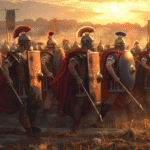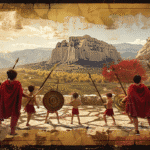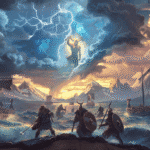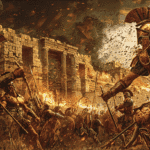Table of Contents
The Legacy of Bjorn Ironside in Norse History: A Comprehensive Study Guide for Understanding Viking Impact
Bjorn Ironside stands among the most celebrated Viking warriors in Norse tradition—a legendary figure whose exploits span from Scandinavia to the Mediterranean, and whose historical reality remains as contested as that of his famous father, Ragnar Lothbrok. Whether as the semi-mythical founder of Sweden’s Munsö dynasty or as the daring raider who struck fear into Francia and beyond, Bjorn’s story illuminates both Viking Age military prowess and the complex relationship between history and legend in Norse culture.
If you’re studying Viking history, medieval Scandinavian politics, or the intersection of mythology and historical fact, understanding Bjorn Ironside provides crucial insights into how warrior culture, dynastic claims, and storytelling traditions shaped both medieval and modern perceptions of the Norse world.
This comprehensive study guide examines Bjorn Ironside from multiple analytical perspectives—genealogical context, historical documentation, military campaigns, legendary embellishments, and cultural legacy—providing the framework to critically evaluate one of the Viking Age’s most intriguing figures.
Key Takeaways
- Bjorn Ironside appears in both historical chronicles and legendary sagas, with the 859-862 CE Mediterranean raid representing his most historically documented campaign
- As son of Ragnar Lothbrok (legendary/composite figure), Bjorn’s own historicity faces similar uncertainties, though his Mediterranean activities have stronger corroboration
- The Munsö dynasty claim—that Bjorn founded Sweden’s ruling house—connects legendary Viking hero to documented Swedish royal lineage, though chronological issues complicate this connection
- His nickname “Ironside” (Járnsíða) reflects Norse traditions of epithets denoting warrior prowess, joining similar names like Harald Hardrada (“Hard Ruler”) in Viking naming conventions
- Modern media, particularly History Channel’s “Vikings,” has dramatically reshaped Bjorn’s popular image while diverging significantly from saga sources

Understanding the Bjorn Ironside Problem: Legend, History, and Evidence
Like his father Ragnar, Bjorn Ironside presents methodological challenges for historians attempting to separate documented events from legendary embellishment.
Source Categories and Reliability
Primary historical sources:
Frankish Chronicles (9th century—contemporary):
- Document Viking raids on Francia
- Name some Viking leaders
- Most reliable for actual events
- Don’t specifically name “Bjorn Ironside”
Annals of St-Bertin:
- Records 859-862 Mediterranean expedition
- Names leaders as “Björn” and “Hastein”
- Provides operational details
- Historical reliability: High for events, medium for attribution
Irish Annals:
- Document Norse activities in Ireland
- Occasional name references
- Fragmentary but contemporary
- Historical reliability: Medium-high for Irish context
Secondary legendary sources:
Norse Sagas (12th-13th centuries):
- Ragnarssona þáttr (Tale of Ragnar’s Sons)
- Hervarar saga ok Heiðreks (Saga of Hervör and King Heidrek)
- Various Icelandic family sagas
- Historical reliability: Low for specifics, high for cultural values
Saxo Grammaticus – Gesta Danorum (c. 1200):
- Danish history compilation
- Different Bjorn narrative details
- 300+ years after supposed events
- Historical reliability: Low for biography, medium for cultural context
Archaeological evidence:
- Viking Age material culture
- Ship technology confirming Mediterranean capability
- Settlement patterns
- Cannot confirm individuals but confirms context
The Bjorn Historicity Spectrum
Most historically certain:
- Viking Mediterranean expedition (859-862)
- Leaders named “Björn” and “Hastein”
- Raids on Spanish and Italian coasts
- Eventual return to Francia
Historically probable:
- A Norse leader named Bjorn/Björn existed
- Participated in major 9th-century campaigns
- Achieved significant reputation
- Connected to Swedish territory
Historically uncertain:
- Specific relationship to “Ragnar Lothbrok”
- Foundation of Munsö dynasty
- Precise genealogical connections
- Biographical details in sagas
Historically unlikely:
- Saga narratives as literally presented
- Supernatural elements
- Precise dialogue and personal details
- Exact chronologies given in sagas
Analytical Framework
Approaching Bjorn critically requires:
- Distinguishing source types (contemporary vs. legendary)
- Identifying corroboration (multiple independent sources)
- Recognizing literary conventions (standard saga tropes)
- Archaeological context (what was possible/probable)
- Comparative analysis (other documented Vikings)
This framework prevents both naive acceptance and dismissive skepticism, allowing nuanced understanding of a complex historical-legendary figure.
Origins and Family of Bjorn Ironside
Bjorn’s family context provides both his legendary significance and historical complications.
Ancestry and the Lineage of Ragnar Lothbrok
The Ragnar connection:
Saga tradition:
- Bjorn consistently identified as Ragnar’s son
- Various sagas agree on this relationship
- Mother usually identified as Aslaug (legendary figure)
- Alternative tradition: Thora as mother (from Saxo)
Historical problems:
- Ragnar Lothbrok’s own historicity contested
- No contemporary sources confirm Ragnar
- Possibly composite of multiple Vikings
- Name means “famous warrior”—possibly title rather than name
Genealogical significance:
If Ragnar existed:
- Bjorn heir to legendary reputation
- Political claim through famous father
- Motivation for campaigns (family honor)
- Brotherhood with documented figures (Ivar, etc.)
If Ragnar legendary/composite:
- Later attribution connecting figures
- Creating pedigree for Swedish dynasty
- Literary device unifying separate stories
- Cultural need for founding heroes
The genealogical pattern:
Norse sagas trace Bjorn through:
- Odin (god—divine ancestry claim)
- Various legendary Swedish kings
- Sigurd Ring (semi-legendary)
- Ragnar Lothbrok (legendary/historical?)
- Bjorn Ironside
This pattern serves political legitimization—connecting historical (or semi-historical) dynasty to divine origins through legendary intermediaries.
Siblings in tradition:
Ivar the Boneless:
- Better historically documented than Bjorn
- Great Heathen Army leader (865)
- Anglo-Saxon Chronicle names him
- Irish annals record “Ímar”
- Historicity: High
Hvitserk (White Shirt):
- Possibly same as Halfdan Ragnarsson
- Less documented than Ivar
- Various death traditions
- Historicity: Low-medium
Sigurd Snake-in-the-Eye:
- Distinctive eye marking legend
- Minimal historical documentation
- Possibly returned to Scandinavia
- Historicity: Low
Ubbe:
- Anglo-Saxon Chronicle mentions
- Possibly killed in Devon (878)
- Great Heathen Army participant
- Historicity: Medium
Sibling significance:
- If brothers historical, suggests family unit existed
- But: Doesn’t prove Ragnar’s specific identity
- Brothers’ varying historicity levels complicate picture
- Possible legendary binding of separate figures
Bjorn Ironside’s Early Life and Upbringing
Saga narratives:
Childhood training:
- Weapons instruction from youth
- Ship navigation and sailing
- Leadership and command skills
- Norse martial traditions
Mother’s identity debate:
Aslaug (saga tradition):
- Daughter of Sigurd the Dragon-Slayer
- Prophetic abilities
- Connection to Völsung cycle heroes
- Historical reality: Legendary character
Lagertha (Saxo’s version):
- Shieldmaiden and warrior
- First wife of Ragnar
- Different chronology than Aslaug narrative
- Historical reality: Uncertain—possibly literary
Thora (alternative tradition):
- Died young in some accounts
- Different saga variants
- Less prominent than Aslaug/Lagertha
- Historical reality: Uncertain
Mother identity significance:
- Reflects saga variation and transmission
- Shows legendary embellishment
- Political implications (which lineage validated)
- Cultural values (warrior women, prophetic mothers)
Historical assessment:
- Specific childhood details: Unknowable
- Viking training practices: Generally documented
- Family structure: Probable but details uncertain
- Literary conventions: Likely influenced narratives
Relations with Key Figures
Family networks:
Father (Ragnar):
- Legendary bond and reputation
- Supposed early campaigns together
- Father’s death motivating later actions
- Reality: Uncertain relationship to uncertain figure
Brothers:
- Cooperative campaigns (saga accounts)
- Rivalries and conflicts (some traditions)
- Shared leadership (Great Heathen Army)
- Reality: Some brothers documented separately
Hastein partnership:
Historical documentation:
- Frankish sources name both “Björn” and “Hastein”
- Mediterranean expedition joint leadership
- Suggests genuine partnership
- Hastein independently documented elsewhere
Significance:
- Best-documented Bjorn relationship
- Historical rather than legendary
- Shows collaborative Viking leadership
- Context for understanding Bjorn’s operations
Political connections:
Swedish territory:
- Claimed founder of Munsö dynasty
- Connections to Swedish kings
- Burial mound (Björnshögen) in Sweden
- Reality: Dynastic claim chronologically problematic
Other Viking leaders:
- Contemporary jarls and chieftains
- Raiding partnerships and rivalries
- Trade and military alliances
- Reality: General context documented, specifics unclear
Bjorn Ironside’s Achievements and Influence
Bjorn’s military campaigns and political legacy represent the intersection of documented Viking activity and legendary enhancement.
Major Viking Raids and Military Campaigns
The Mediterranean Expedition (859-862 CE):
Historical documentation:
Frankish Annals account:
- Fleet departed Loire River region (859)
- ~62 ships (varying accounts)
- Leaders: Björn and Hastein
- Three-year campaign
- Returned 862
Campaign details:
Year 1 (859-860): Iberia
- Raided Spanish coast
- Attacked Kingdom of Asturias
- Captured Pamplona (Navarre)
- Held king for ransom
- Significant plunder taken
Year 2 (860-861): North Africa and Italy
- Crossed to North Africa
- Raided Moroccan coast
- Entered Mediterranean proper
- Attacked southern France (Provence)
- Raided Italian coast
The “Rome” incident (legendary):
- Saga tradition: Mistook Luna for Rome
- Feigned death to gain entry
- Captured city through deception
- Historical basis: Possibly attacked Luna (Luni)
- Embellishment: Probably exaggerated details
Year 3 (861-862): Return journey
- Attacked Balearic Islands
- Continued raiding Spanish coast
- Muslim fleet engagement (losses)
- Returned through Gibraltar
- Attacked Navarre again
- Returned to Francia (862)
Significance:
Geographic extent:
- Furthest Mediterranean penetration documented
- Demonstrated Viking navigation capabilities
- Showed strategic planning (three-year expedition)
- Required sophisticated logistics
Military achievement:
- Successfully operated far from home
- Adapted to Mediterranean climate/conditions
- Conducted diverse operations (naval, siege, raids)
- Returned with substantial plunder
Historical impact:
- Proved Viking reach extended beyond northern Europe
- Influenced Islamic and Christian Mediterranean powers
- Created legends inspiring later Vikings
- Demonstrated Viking ship technology effectiveness
Other campaigns (less documented):
Frisia and Francia:
- Various raids in 850s-860s
- Part of broader Viking activities
- Difficult to separate Bjorn specifically
- General Viking context well-documented
Scandinavia:
- Internal conflicts and consolidation
- Building Swedish territorial power
- Less documented in external sources
- More legendary in saga accounts
British Isles:
- Some traditions place Bjorn in England/Ireland
- Harder to confirm than Mediterranean campaign
- May conflate with brothers’ activities
- Historical uncertainty higher
Leadership and the Founding of Viking Kingdoms
The Munsö Dynasty claim:
Saga tradition:
- Bjorn founded Swedish Munsö dynasty
- Ruled from Birka or nearby
- Passed power to descendants
- Created lasting kingdom
Historical complications:
Chronological problems:
- Munsö dynasty dates: ~10th century onward
- Bjorn’s supposed lifetime: mid-9th century
- Gap of 50-100 years
- Doesn’t align cleanly
Possible explanations:
- Legendary retrojection: Later dynasty claimed ancient hero ancestor
- Chronological compression: Multiple generations compressed in memory
- Different Bjorn: Later figure conflated with earlier hero
- Purely legendary: No actual connection
Swedish royal connections:
Documented Swedish kings:
- Eric the Victorious (970s-995)
- Olof Skötkonung (995-1022)
- Later kings claiming Munsö descent
Bjorn’s claimed position:
- Legendary founder/ancestor
- Provides pedigree legitimacy
- Connects to Viking Age glory
- Political utility for later rulers
Leadership characteristics (saga portrayal):
Military leadership:
- Strategic thinking (Mediterranean planning)
- Tactical adaptability (diverse operations)
- Inspirational presence (maintaining loyalty)
- Risk calculation (long-distance expedition)
Political skill:
- Alliance building (Hastein partnership)
- Diplomatic capabilities (ransom negotiations)
- Resource management (three-year expedition)
- Long-term planning (kingdom building)
Cultural leadership:
- Embodying Viking values
- Setting warrior standards
- Creating legendary reputation
- Inspiring later generations
Role in the Expansion of Viking Age Territories
Geographic impact:
Scandinavian consolidation:
- Contributing to Swedish kingdom formation
- Part of transition from chieftains to kings
- Role in Birka/Uppsala region power
- Historical certainty: Low for specifics, probable for general contribution
Mediterranean reach:
- Demonstrated Viking capability
- Opened routes for trade/raid
- Influenced southern European perceptions
- Historical certainty: High for expedition, medium for lasting impact
Atlantic context:
- Contemporary with Iceland settlement beginnings
- Part of broader Norse expansion era
- Connected to Greenland/Vinland explorations
- Historical certainty: General context only
Territorial expansion mechanisms:
Raiding:
- Wealth extraction funding further expansion
- Weakening target regions
- Creating fear enabling future demands
- Establishing reputation
Settlement:
- Some raid participants staying
- Intermarriage with local populations
- Establishing trade networks
- Creating Norse diaspora communities
Political pressure:
- Forcing treaties and tribute
- Creating client relationships
- Weakening rival kingdoms
- Enabling later conquest
Bjorn’s role assessment:
- Definitely contributed through raiding
- Possibly contributed through settlement establishment
- Probably influenced through reputation
- Unclear specific kingdom-building achievements
Interaction with Historical and Legendary Figures
Documented interactions:
Hastein:
- Joint Mediterranean expedition
- Shared leadership model
- Complementary skills possibly
- Historical reality: Well-documented partnership
Charles the Bald (Frankish King):
- Bjorn’s forces opposed by Charles’s
- Treaty negotiations possible
- Tribute payments (Danegeld)
- Historical reality: General conflict documented, specific Bjorn interaction unclear
Legendary interactions:
Ragnar Lothbrok (father):
- Saga extensive father-son dynamics
- Shared early campaigns
- Ragnar’s death motivating sons
- Historical reality: Uncertain—Ragnar’s existence unclear
Anglo-Saxon kings:
- Various saga references to English campaigns
- Aethelwulf, Edmund, Alfred mentioned
- Conflicts and negotiations
- Historical reality: These kings historical, Bjorn’s interaction uncertain
Brothers:
- Cooperative Great Heathen Army leadership
- Rivalries over leadership/inheritance
- Mutual support and conflicts
- Historical reality: Some brothers documented, relationships uncertain
Norse gods:
- Saga references to Odin’s favor
- Thor’s protection implied
- Divine ancestry claims
- Historical reality: Religious/cultural context, not literal
Interaction significance:
- Historical figures Bjorn “met” were real
- Specific interactions mostly legendary
- General Viking-target dynamics documented
- Personal relationships unknowable
Cultural and Mythological Impact
Bjorn’s legendary status extends beyond historical debates to shape Norse cultural memory and identity.
Depictions in Norse Mythology and Literature
Saga presentations:
Ragnarssona þáttr (Tale of Ragnar’s Sons):
Bjorn’s characterization:
- Brave and strong warrior
- Loyal to father’s memory
- Ambitious for own glory
- Strategic thinker
Key episodes:
- Mediterranean expedition (semi-historical)
- Conflicts with brothers (legendary)
- Various battles and raids
- Return to Sweden and kingdom
Literary function:
- Exemplifying Viking values
- Creating heroic model
- Explaining historical events (retrospectively)
- Entertainment and cultural reinforcement
Hervarar saga ok Heiðreks:
- Different Bjorn narrative strand
- Connects to Swedish kings
- Legendary battles and deeds
- Shows saga variation
Saxo Grammaticus version:
- Gesta Danorum (Book 9)
- Differs from Icelandic accounts
- Danish vs. Icelandic perspectives
- Shows transmission variety
Literary themes:
Heroism:
- Courage in battle
- Willingness to face danger
- Personal honor maintained
- Fame sought through deeds
Loyalty:
- To father (Ragnar)
- To brothers (sometimes)
- To followers and warriors
- To Norse values generally
Ambition:
- Seeking kingdom and power
- Expansion and exploration
- Creating legacy
- Surpassing predecessors
Fate:
- Norse concept of ørlǫg (fate)
- Destiny guiding actions
- Accepting what must be
- Wyrd (similar concept)
Connection to mythological elements:
Divine favor:
- Odin’s alleged descendant
- Battle success as divine sign
- Prophetic elements (mother Aslaug)
- Destiny fulfillment
Supernatural beings:
- Light elves and dark elves (Norse cosmology context)
- Valkyries (warrior death traditions)
- Giants (enemies in some accounts)
- General mythological worldview
Saga function:
- Entertaining medieval audiences
- Preserving cultural memory
- Teaching values and norms
- Connecting past to present
Legacy in Scandinavian and Norse Culture
Swedish national identity:
Munsö dynasty connection:
- Founder myth significance
- Legitimizing Swedish monarchy
- Connecting modern Sweden to Viking glory
- National pride element
Archaeological tourism:
- Björnshögen burial mound
- Tourist destination in Sweden
- Birka World Heritage Site connections
- Viking heritage industry
Cultural symbolism:
Warrior ideal:
- Bjorn represents Viking warrior archetype
- Courage, strength, independence
- Exploration and adventure
- Freedom and individualism
National character:
- Swedish/Scandinavian identity elements
- Historical pride and heritage
- Nordic cooperation (pan-Scandinavian hero)
- Connection to pre-Christian past
Gender dynamics:
Mother figures:
- Aslaug’s prophetic wisdom
- Lagertha’s warrior prowess (if connected)
- Women’s roles in Viking society
- Shieldmaiden traditions
Interpretation:
- Modern debates about historical warrior women
- Archaeological evidence (Birka warrior grave debate)
- Cultural values around gender
- Saga literary conventions vs. historical reality
Modern Scandinavian connection:
Heritage organizations:
- Historical reenactment groups
- Viking festivals and events
- Educational programs
- Archaeological societies
Political usage:
- Nationalist movements invoking Viking past
- Nordic cooperation symbolism
- Tourism marketing
- Cultural diplomacy
Critical modern perspectives:
- Questioning romanticization
- Acknowledging violence and slavery
- Balancing pride with historical honesty
- Decolonizing Viking narratives
Bjorn Ironside in Modern Popular Culture
Television and film:
History Channel’s “Vikings” (2013-2020):
Bjorn’s portrayal (Alexander Ludwig):
- Main character from seasons 2-6
- Character arc: Child to warrior to king
- Personality: Brave, honorable, sometimes reckless
- Relationships: Complex family dynamics
Narrative choices:
- Mediterranean raid dramatized
- Swedish kingdom storyline
- Brothers’ relationships emphasized
- Romantic relationships invented/altered
Historical accuracy assessment:
What the show does well:
- Captures Viking aesthetic (ships, clothing, settings)
- Shows strategic thinking in raids
- Depicts complex politics
- Archaeological consultant input
What the show changes:
- Timeline compressed and altered
- Character personalities modernized
- Relationships invented or changed
- Supernatural elements reduced
Cultural impact:
- Massive global audience
- Renewed interest in Vikings
- Tourism boost to Scandinavian sites
- Academic outreach opportunities
Other media appearances:
Video games:
- Assassin’s Creed Valhalla (references)
- Crusader Kings series (playable/referenced)
- Total War series (Viking factions)
Literature:
- Historical fiction novels
- Young adult Viking adventures
- Fantasy incorporating Norse mythology
- Modern translations of sagas
Comics:
- Various Viking comic series
- Norse mythology adaptations
- Historical graphic novels
Why Bjorn resonates with modern audiences:
Adventure narrative:
- Exploration and discovery
- Exotic locations (Mediterranean)
- Overcoming obstacles
- Freedom and agency
Warrior ethos:
- Martial skill and courage
- Honor and loyalty codes
- Individual prowess
- Overcoming adversity
Family dynamics:
- Father-son relationships
- Sibling rivalries and alliances
- Legacy and inheritance
- Generational patterns
Cultural difference:
- Norse paganism fascination
- Alternative value systems
- Pre-Christian European culture
- Different social structures
Modern reinterpretations:
Feminist readings:
- Warrior women in Bjorn’s story
- Female agency and power
- Questioning traditional gender roles
- Archaeological evidence debates
Postcolonial perspectives:
- Vikings as raiders and colonizers
- Violence against indigenous populations
- Slavery in Viking society
- Complicated legacy acknowledgment
Nationalist concerns:
- Far-right appropriation of Viking imagery
- White supremacist misuse of Norse symbols
- Scholarly pushback and correction
- Reclaiming Viking heritage inclusively
Critical Analysis: Evaluating Bjorn’s Historical and Cultural Significance
Synthesizing evidence and interpretation:
What Can We Actually Know About Bjorn?
High confidence:
- Mediterranean expedition (859-862) occurred
- Viking leaders named “Björn” and “Hastein”
- Raiders reached Italy, North Africa, Iberia
- Returned to Francia with plunder
- Expedition entered Norse legendary tradition
Medium confidence:
- A notable Norse leader named Bjorn existed 9th century
- Connected to Swedish territory
- Achieved significant warrior reputation
- Inspired legendary traditions
- Possibly related to other documented Vikings
Low confidence:
- Specific relationship to “Ragnar Lothbrok”
- Precise genealogy as presented in sagas
- Founding of Munsö dynasty (chronological problems)
- Specific personal details and biographical events
- Relationships with brothers as saga describes
Essentially unknowable:
- Childhood experiences and training
- Personal motivations and thoughts
- Exact parentage
- Many specific raid details
- Personal relationships and dynamics
Why Bjorn Matters for Viking Studies
Military history:
- Exemplifies Viking Age naval capabilities
- Shows strategic planning sophistication
- Demonstrates geographic reach
- Illustrates raiding-to-state formation transition
Cultural history:
- Shows how Vikings created legendary heroes
- Illustrates saga composition and transmission
- Demonstrates values and ideals transmission
- Reveals political uses of genealogy
Historiography:
- Case study in legend vs. history
- Shows source criticism methodology
- Illustrates oral tradition and written compilation
- Demonstrates historical uncertainty management
Popular culture:
- Shows modern engagement with medieval past
- Illustrates history’s uses and misuses
- Demonstrates heritage tourism impact
- Reveals contemporary values through historical lens
Recommended Study Approach
Primary sources:
- Read Ragnarssona þáttr (Tale of Ragnar’s Sons)
- Examine Frankish Annals entries (859-862)
- Review Saxo Grammaticus (Book 9)
- Compare different saga versions
Secondary scholarship:
- Viking Age military history
- Norse saga criticism and analysis
- Swedish medieval history
- Mediterranean Viking activities
Archaeological context:
- Viking ship technology
- Birka settlement archaeology
- Mediterranean Viking material evidence
- Burial practices and mounds
Cultural analysis:
- Norse values and worldview
- Medieval Scandinavian politics
- Genealogy and dynastic legitimation
- Saga composition and transmission
Critical media consumption:
- Watch “Vikings” series critically
- Compare depictions to sources
- Identify entertainment vs. history
- Recognize modern values imposed
Conclusion: The Enduring Legacy of Bjorn Ironside
Bjorn Ironside occupies a fascinating position in Viking studies—more historically grounded than his father Ragnar, yet still wrapped in legendary embellishment that makes certainty impossible. The Mediterranean expedition provides a documented core around which saga tradition built a fuller heroic narrative, connecting this 9th-century warrior to both divine ancestry and Swedish royal lineage.
What we can conclude:
Historical contribution:
- Bjorn (or a Viking leader by that name) conducted significant raids
- The Mediterranean expedition demonstrated Viking reach and capability
- His reputation inspired legendary traditions
- Possibly contributed to Swedish kingdom formation
Cultural significance:
- Exemplifies Viking warrior ideal in Norse tradition
- Serves political function legitimizing Swedish dynasty
- Embodies values Norse culture wished to preserve
- Creates connection between Viking Age and later Scandinavia
Modern relevance:
- Popular culture keeps Viking interest alive
- Scholarly debates continue on historicity
- Heritage tourism driven by legendary associations
- Contemporary identity connections to Viking past
The scholarly position: The most intellectually honest approach to Bjorn Ironside acknowledges what we know, what we can reasonably infer, and what remains uncertain. He was probably real, definitely achieved significant fame in his lifetime, and certainly became legendary afterward. The Mediterranean expedition happened; whether every detail of the saga narratives is true remains unknowable.
For students and enthusiasts: Approach Bjorn Ironside as a window into both Viking Age realities and how medieval Scandinavians understood their past. Use his story to understand source criticism, the relationship between oral tradition and written text, and how legends serve cultural functions while potentially preserving historical kernels. Let the uncertainty enhance rather than frustrate your engagement with this complex, fascinating figure.
Whether Bjorn Ironside founded Swedish dynasties, simply raided impressively, or represents several Vikings combined into one legend, his story illuminates how the past lives through memory, story, and cultural need—making him valuable for understanding history, even if we can never fully know the historical person behind the legendary warrior.




